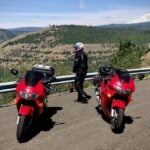The Forgotten Gladiators of the Motorcycle Arena
No one will argue that it takes guts to race any motorcycle. Modern motorbike racing continues to excite and thrill in a way that no other sport can match. Even the most hardened Formula 1 or NASCAR fans will concede that those who risk life and limb on board these two-wheeled rockets are of a different breed.
But at the turn of the 20th century, two wheeled racing looked very different indeed. Early motorcycle racing is documented to have started in the UK, with the first official race in 1897 at Sheen House. It wasn’t long before the phenomenon took hold across the pond. But whereas British racing took part on repurposed horse racing tracks and closed roads, the US interpretation evolved into “board tracks.”
Board track construction and maintenance was in itself a risky endeavor.
The idea was simple: use the same design of circuits that had existed for pedal-powered competition, otherwise known as velodromes. These wooden tracks featured oval layouts with steep banks. Competitive motorcycles of the time resembled bicycles with engines strapped into them, so the development almost seemed natural.
The larger and more sturdy circuits created were called motordromes and could even incorporate automobile races. Before long, a US calendar of racing was published, with about 24 tracks across the country. The public loved it. The speeds achieved by these daredevils on two wheels were something that had never been witnessed in history. With some banks as steep as 50 degrees or higher, the racing became faster and more dangerous.
Wells Bennett astride his heavily modified Excelsior 7 within the 62.5 degree steep banks of the St. Louis Motordrome, summer 1914.
But popularity was booming. All the major motorcycle manufacturers saw participation. Companies such as NSU and Indian led the way, with the riders becoming the gladiators of their era. After shying away from the concept initially, Harley-Davidson made their own successful entry in the 1910s. Their team, owing to continual success, was dubbed “The Wrecking Crew.” Harley’s racers soon became the early superstars of motorcycle racing. At the same time, winning Harley rider Ray Weishaar popularized the term “HOG” thanks to his pet pig, whom he carried around on his frequent victory laps.
But the board tracks were set to be a short-lived feature in US motorsport. With speeds getting higher and many bikes getting faster- some riders reaching speeds of 100 mph- the dangers continued to mount. The threat that had initially served as a crowd drawing novelty soon turned into negative PR.
The racing was intense, fast, steep, and dangerous for both riders and fans, for obvious reasons.
The board track layouts themselves were dangerous, not only for riders but for spectators as well. With hundreds sitting on top of the tracks, peering down the banks, the risk was immense. In one particularly horrific incident at the 1912 Nutley, New Jersey velodrome, “Texas Cyclone” Eddie Hasha wiped out at over 90 mph, killing him on impact. His bike careened into the stands, reportedly decapitating a boy who had peered through the railings, then killing several other spectators, before falling back onto the track and into the path of another rider, Johnny Albright. Albright would also lose his life in the catastrophic crash.
Many point to this grisly low-point as the beginning of the end for board track racing. The incident made front page news, while outlets across the country began to label motordromes as “murderdromes.” In addition to the dangers, the tracks themselves were borderline unsuitable for racing. Not only did they deteriorate- on average of five years before complete refurbishment was required- the splintered surfaces were deadly for spectators, mechanics, and any rider who went down at speed. All of this, coupled with the woes of the Great Depression, meant that as the 1930s progressed, board track racing would eventually disappear.
Several beautiful restorations and recreations of board track legends, on display at Throttlestop.
While the board track races themselves may be relegated to the history books, the preservation and reincarnation of the bikes that made up this legendary era of racing means such gladiatorial machines can still be experienced up close and personal today.
Bikes such as the recreation of 1913’s Gladiator Racer, and an original 1931 Harley Davidson Peashooter, can all be experienced courtesy of our friends at the Throttlestop Motorsports Museum. Also on display is the 1000cc 1914 Indian Twin Board Track Racer, a bike that could reach near 100 mph- but with no brakes. They also possess a replica 1925 Harley Davidson Track Racer, it too with a 1000cc engine, rigid frame, and external oil pump.
If you ever want to gaze upon reminders from an era of literal racing rock stars, check out the Throttlestop Museum in Elkhart Lake, Wisconsin, or take a free virtual stroll through their collection by entering your email and signing in here (so worth it):
*Photos by Throttlestop and the Museum of American Speed






























My Grandfather worked as a mechanic on board track Harley Davidsons. I have pictures of him in action.
Did you post one of him on social media? That was a fantastic picture, Thomas. Thanks for sharing it.
Rad dude!!